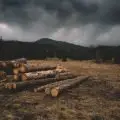If you are finding yourself in a situation where a tree must be cut down but you lack the help of others to do it, then there is no need to worry. It can be done completely alone by you and your tools alone! We’ll provide you with the knowledge and tips you need to undertake this task with confidence. But remember, while DIY tree removal can be rewarding, it’s crucial to prioritize safety and consider professional assistance for particularly challenging situations.
Table of Contents
- Can You Cut a Tall Tree By Yourself?
- Safety Tips
- Equipment You’ll Need
- How to Cut Down a Tall Tree by Yourself
- How to Cut a Tall Tree Down By Yourself Video Summary
- How to Cut a Tall Tree Demonstration
- DIY vs Hiring a Professional: What to Consider
- A Note to Remember
- FAQs (Frequently Asked Questions)
Can You Cut a Tall Tree By Yourself?
Cutting down a tree on your own can be difficult, especially if the tree is tall. However, it is not impossible and as long as you’re safe and plan it out, can be quite easily achievable.
While a step-by-step plan would yield good results, there are a lot of things to take into consideration before you can actually begin the process of cutting a tree down. Tree removal is about a lot more than just cutting a tree down and hoping for the best. Before you begin cutting, there are a lot of proper safety precautions that you must have in place such as safety gear and escape routes.
Safety Tips
Your number one priority throughout the entire procedure should be your safety, and anyone else’s who may be nearby. By this, I am talking about having the correct safety gear and multiple escape routes (a single escape route is okay but it is best to have two escape routes or more just in case of a falling tree going in an unpredicted direction).
Safety is extremely important when it comes to felling trees and using chain saws in general. You must take it seriously.
Safety Equipment You’ll Need
There are a few absolutely essential pieces of safety equipment you need to wear for any chain saw work, especially when cutting down a tall tree.
- A helmet protects you from falling branches, which is a very common cause of injuries.
- Earmuffs and a face screen will protect your ears and eyes.
- Safety glasses will keep the dust away from your eyes.
- Kevlar chaps will stop a chain instantly should you happen to drop the bar against your leg. (For more on how to use a chainsaw safely, visit our guide!)
Safety Considerations
To remain safe throughout your how to cut down a tall tree by yourself operation, do the following:
- Check all tools prior to use to ensure they are in safe working condition.
- Use new cutting blades and chains.
- Wear PPE (personal protective equipment) gloves, footwear, and a hard hat.
- If using an extension ladder, make sure you secure it to the tree with a rope to prevent slippage.
- Ask for help from someone. They can assist in directing falling branches and trunk sections.
- Clearly communicate plans and drop zones to the person working with you.
When cutting down a tall tree, you’ll be a lot safer if you have someone standing in a safe location observing the top of the tree for falling branches and letting you know when the tree starts to fall. A good system to have is your assistant tapping you on the shoulder with a stick to alert you when it’s time to vacate the area for any falling branches.
If you’re early into a cut and you get the tap on the shoulder, you should immediately leave the chainsaw and walk away. If you’re near the end of a cut, a shoulder tap means the tree is beginning its fall.
Equipment You’ll Need
Here’s a list of essential equipment you’ll need:
- Chainsaw: A powerful and well-maintained chainsaw with a bar length suitable for the diameter of the tree. Ensure it’s equipped with a sharp chain to make clean cuts.
- Safety Gear:
- Helmet with face shield or safety goggles: To protect your head and eyes from falling debris and sawdust.
- Hearing protection: To safeguard your ears from the chainsaw’s noise.
- Chainsaw chaps or pants: To protect your legs from potential cuts.
- Steel-toed boots: To shield your feet from heavy falling branches and provide stable footing.
- Gloves with a good grip: To protect your hands and improve chainsaw handling.
- Felling Wedges: To control the direction of the tree’s fall. Inserting wedges into the felling cut can help prevent the tree from pinching your chainsaw and steer it in the intended direction.
- Axe or Hammer: To drive the felling wedges into the cut.
- Rope: Useful for guiding the direction of the tree’s fall, especially if it’s leaning in an undesired direction or if there’s a risk of it falling onto structures.
- First Aid Kit: Always have a first aid kit nearby in case of minor injuries.
- Escape Route: Not equipment per se, but planning two escape routes opposite to the direction in which the tree is expected to fall is essential for your safety.
- Tree Felling Signs: To warn others that tree felling is in progress, especially if you’re working in a populated area or near footpaths.
How to Cut Down a Tall Tree by Yourself
1. Study the Tree & Felling Zone
The first step for how to cut tall trees is to estimate the felling zone. Trees are taller than you perceive and will reach farther on the ground than you likely expect. When you’re planning on cutting a tall tree, you can estimate where a tree will fall by using something called the “ax handle trick.”
The ax handle trick involves holding an ax handle at arm’s length, closing one eye, and then backing away from or moving toward the tree until the top of the ax is even with the treetop and the bottom is even with the base. This then estimates that your feet should be roughly where the treetop will fall to.
NOTE: This is just an estimate, therefore, you should allow extra room if there’s anything the tree may fall on!
Now, study the tree to ensure it is safe to cut down yourself. If you see that the tree has dead branches, it is leaning, or there are obstructions in the felling zone, you should NOT cut it down yourself and seek professional help.
Be wary of dead branches that are broken but attached, or that are actually broken off and supported by other branches because you’re undoubtedly going to knock a branch loose and have it fall on you or your assistant. If the tree is obviously leaning in one direction or heavily loaded with branches on one side. It will fall in the direction of the lean or load regardless of your best efforts. Assess your zone for any buildings, fences, power lines, or other things you care about.
Learn how to cut a leaning tree in the opposite direction, in our guide!
2. Clear the Cutting Zone
After assessing your cutting zone, before you begin any cutting, move vehicles, lawn ornaments, and any non-stationary sheds or equipment out of the area. This will prevent damage from any falling branches or trunk sections.
You must make sure that all pets and young children are safely indoors and do not step outside at any point to eliminate the risk of them suffering any accidental injuries.
Even when you’re sure which way the tree is going to fall, you’re still not ready to cut it. You should cut away any brush around the trunk, and then clear two escape routes on the “non-falling” side of the tree. In general, they should be about 45 degrees away from each other in opposite directions if possible. The last thing you want is to trip over while trying to escape a falling tree.
3. Cut Lower Branches
Now you can begin the cutting tasks. You should start by cutting off the lower branches of the tree. These lower branches are typically larger and heavier than higher branches.
The trick here is to first make an undercut by sawing upwards from the underside of the branch, roughly 1/4 of the way through the branch. Then, saw downwards from the top of the branch around 6-12 inches from the trunk to the undercut. This will allow for the branch to fall cleanly. If necessary, use a rope to control the falling of large and heavy branches.
Practice safe handling of your chainsaw. Branches that are cut improperly are prone to splintering and falling in uncontrolled ways, or even swinging back towards you and your ladder. While a properly cut branch will drop straight down in a clean manner.
4. Cut Upper Branches
After cutting off the lower branches, it’s time to tackle the upper branches. Set up your tripod ladder, or use a rope to secure your extension ladder to the tree to prevent the ladder from slipping or falling. Then, use your chainsaw to cut off the upper branches.
Rather than attempting to climb the ladder with the saw in hand, you should tie a rope to the handle of the saw and bring the rope up with you. Once you’ve reached the upper portion of the ladder, you can simply haul the chainsaw up to yourself in a safe manner.
It’s advised to tie a rope around the branches that are large in case they fall and damage your house. To do so, you should wrap the other end at ground level around another tree trunk. With the help of 1 or more assistants, unwrap the rope around the tree trunk and begin to slowly lower the large branch to the ground.
NOTE: Make sure to never wrap the rope around your hand or fingers when lowering a branch. A rope pulled tight around your fingers by the weight of a branch can cause serious injury.
5. Plan & Cut Your Notch
Now that the tree is de-limbed, you can begin attacking the trunk. First of all, you are going to be cutting a notch on the “fall” side of the trunk. Sight along the handle and adjust the saw until it’s pointing toward your fall direction.
The center of the notch will be the spot where the bar touches the bark. Before making the cut, it’s advised to plan out the notch by marking it with chalk or by scoring the bark with the chain saw. The rule of thumb is to make the depth of the notch 1/4-1/3 of the tree trunk’s diameter and to ensure it is at a comfortable working height.
6. Make the Felling Cut
It’s time to use the chainsaw to cut through the tree from the opposite side, toward the notch. You should make the top cut first and then the bottom. When you’re making the bottom cut, adjust your hand to control the throttle of the chainsaw with your thumb.
The wedge will drop out of the notch if you meet the top-notch perfectly. However, it’s more likely you’ll have to extend the cuts from either the top or the bottom so the wedge can drop free. The felling cut should meet the point of the notch.
The exact moment the tree begins leaning, you should pull the chainsaw free, set the chain brake, and walk away along one of your planned escape routes. Ensure you keep an eye on the tree so you can react if it doesn’t fall the way you intended.
NOTE: Never take your eye off a falling tree.
It’s generally advised to use wedges if you’re felling a tree that’s more than 18 in. in diameter. You should proceed to make your notch cut and begin the felling cut, but as soon as you’ve penetrated far enough to pound wedges behind the bar stop.
Leave the bar in the cut with the saw running, but lock the chain brake and slowly tap in the wedges. This will allow you to finish the cut with the wedges helping keep the saw from getting pinched in the cut if the tree leans back.
7. Cut the Tree into Sections
Now that your tree is safely on the ground, you can being to cut the trunk and limb into sections. I recommend cutting the trunk into sections roughly the length of your forearm, as these are easy to dispose of or use for firewood.
While you may not need to use the tree for firewood, your neighbors or people in the area may. Advertising firewood for free on Facebook or Craigslist is a great way to get rid of a cut-down tree at absolutely no cost to yourself. Many people will be more than happy to load and haul away a sectioned tree, which essentially cleans up your yard for you!
How to Cut a Tall Tree Down By Yourself Video Summary
How to Cut a Tall Tree Demonstration
DIY vs Hiring a Professional: What to Consider
Some people would insist on cutting a tree down by themselves, whereas other people would hire an arborist. Arborists, also known as tree surgeons, are paid professionals who know how to cut a tall tree. There are many factors to take into consideration if you cannot decide between these two options.
Cost
One huge aspect to take into consideration is the cost of the procedure. This means the cost of everything you need to prepare, to actually do it, and to finalize the whole thing. If you need anything extra that you do not already have, you will have to be willing to go and buy your missing tool. If you are not wanting to do something like that, then hiring an arborist might be more for you. They are more expensive, but are more efficient and take less time.
How Much Does an Arborist Cost?
The pricing of an arborist is very dependent on multiple factors. These factors include:
- How tall is the tree?
- How many limbs does the tree have?
- Where is the tree located?
- How easy is it to access and then cut down the tree?
Assuming your tree is around 60 feet tall and in a garden that is rather spacious, then you will be looking at a fee of nearer $1000. This does include the entire process including removal, which is not too bad.
How Much Will the Tools Cost to Do It Alone?
This is entirely dependent on what you already own. Some people may have absolutely everything they will need already stored in their shed, others may not be as lucky and will have to stock up on a few items. To best see what you still need there will be a list, later on, that shows everything you will require. As for pricing, even without anything being owned prior to this you will most likely spend less than you would on an arborist.
They are professionals and you pay a premium for such, whether that works for you or not entirely depends on your attitude towards activities such as this. Some people would happily pay a premium for this to be done for them, whereas other people love to do it themselves. Neither group is wrong and it is all up to you.
Time Is Money
You hear this phrase all the time, so much so that it even applies now. The pricing of cutting down a tree also comes down to if you can afford the time it takes. While some may think of it as a daylong activity, some people cannot afford to have a day off or spend one of their free days doing such a thing. While not everyone has the same amount of free time, some people value theirs more or have other things planned on the days they get off.
If you are in a situation where spending your Saturday cutting down a tree is fine, then that is brilliant and you are good to go. However, other people may always have plans that they cannot cancel. So if you are finding it hard to justify spending a day cutting down a tree, then hiring an arborist is probably your safer bet.
Personal Physical Capabilities
Tree removal is hard work and falling a tree is nothing to scoff at. It is easy to bite off more than you can chew, especially when underestimating a large tree. This is why it is important to take your own physical health and capabilities into account before deciding to do this alone.
Anyone who has cut down a tree can tell you that it is hard and dangerous work. Not only can it go wrong and damage property, but it can also damage you. Tree surgeons have a staggeringly high death rate just because of this. They are on the lookout for falling branches, debris, and tree limbs all the time and can easily miss something. Not to mention how trees can sometimes fall in an unpredictable direction and cause damage on a mass scale.
Without being too morbid, when you are felling a tall tree or a large tree, you are taking a huge risk by doing so alone. If you are up for the task then make sure you take all the safety precautions necessary. If not, then that is absolutely fine, and hiring an arborist will be a better choice for you.
A Note to Remember
If the tree is particularly tall, near power lines, or close to buildings, it’s strongly advised to consult with or hire a professional tree removal service to mitigate the risk of property damage or personal injury.
FAQs (Frequently Asked Questions)
How do you take down a tall tree by yourself?
The first step is to study the tree & felling zone to ensure it is safe to cut down the tree before clearing the zone. When it’s safe to begin, focus on cutting the lower branches first before the upper branches. After removing the branches, you can plan and cut your notch before making the felling cut. Finally, cut the fallen tree into sections the length of your forearm.
What is the best way to cut down a tall tree?
Use a chainsaw to make the notch cut low in the trunk and parallel to the ground. This cut should reach about 1/4 to 1/3 of the way through the tree trunk. Then you can make a diagonal cut at a 45-degree angle above or below the initial cut, removing a wedge of wood from one side of the tree. When the tree begins leaning, pull the chainsaw free, set the chain brake, and walk away along one of your planned escape routes.
Can you cut down a tree yourself?
Yes, if you plan out how you’re going to cut the tree, ensuring the fall zone is clear and it is indeed safe to cut the tree down without help, it is possible. Make sure you remove all lower and upper branches before creating a notch and felling the tree.





